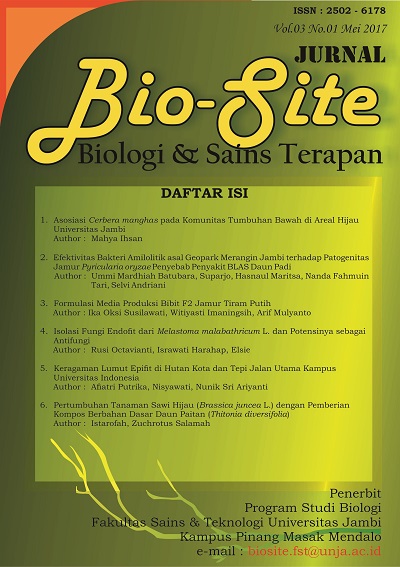Efektivitas Bakteri Amilolitik Asal Geopark Merangin Jambi terhadap Patogenitas Jamur Pyricularia oryzae Penyebab Penyakit Blas Daun Padi
Keywords:
amylolytic, Pyricularia oryzae, blast diseaseAbstract
Rice (Oryza sativa) is a major crop product in Asia. Rice products are increasing along with the increasing of human population. Blast disease in leaf (leaf blast) is the major pathogen in rice during vegetative phase. The using of amylolytic bacteria isolated from Geopark Merangin Jambi is done as an attempt to discover biocontrol agents in order to attack infection of Pyricularia oryzae, the cause of leaf blast disease. Antimicrobial activity assay was carried out by isolating the pathogen in the infected rice crops. Pyricularia oryzae that had been cultured then were evaluated their antagonistic activity against amylolytic bacteria isolated from prior experiment. Results have shown that from 25 isolates of amylolytic bacteria taken from Geopark Merangin Jambi, 2 isolates that can be used as biocontrol agents were GM20 and GM23 capable of inhibiting the growth of Pyricularia oryzae.
Downloads
References
2. Barnett, 1960. Imperfectii Fungi. Burgess Publishing Company Virginia
3. Batubara, U.M.,Susilawati, I.O., & Riany, H. 2015. Isolasi dan karakterisasi bakteri indigenous tanah di kawasan kampus Universitas Jambi. Prosiding Semirata. Hal. 243-250. Universitas Tanjungpura. Pontianak.
4. Campos, S. L & San, S. B. 2009. Assessment of blast disease resistance in transgenic PRms rice using a gfp-expressing Magnaporthe oryzae strain. Plant Pathology. 58: 677–689
5. Gebremariam, A. M., Selvaraj, T., Woldeab, G.2015.Assessment of disease intensity and isolates characterization of blast disease (Pyricularia oryzae CAV.) from South West of Ethiopia Int. J. of Life Sciences, 2015, Vol. 3(4): 271-286
6. Dutta S, Rani TS, Podile AR.2013. Root exudate-induced alterations in Bacillus cereus cell wall contribute to root colonization and plant growth promotion. J PlosOne. 8(10):e78369.
7. Kharisma, S.D., Cholis, A & Qurata’aini, L. 2013. Ketahanan Beberapa Genotif Padi Hibrida (Oryza Sativa L.) Terhadap P. oryzae Cav. Penyebab Penyakit Blas Daun Padi. Jurnal HPT. 1(2): 19-21.
8. Nasution, A & Usyati N. 2015. Observasi ketahanan varietas pdi lokal terhadap penyakit blas (Pyricularia grisea) di rumah kaca. Pros Sem Nas Masy Biodiv Indon. 1(1): 19-22.
9. Nurliana. 2012. Uji Efektitifitas Bakteri Pseudomonas flourescens dari Beberapa Rizosfer Terhadap Penyakit Virus pada Tanaman Cabai (Capsicum Annum L.) di Lapangan. Tesis. Universitas Sumatra Utara.
10. Ou, S.H. 1985. Rice Disease. Commonwealth. Inst. Kiew, Surrey, England. 368 p.
11. Pelczar, M.J. dan E.C. Chan. 1988. Dasar-dasar Mikrobiologi. Jakarta: Universitas Indonesia Press.
12. Puslitbang Tanaman Pangan, 2012. Peningkatan Produksi Padi Menuju 2020.http://pangan.litbang.deptan.go.id/index.php?bawaan=download/download_detail&&id=35. Diakses tanggal 8 Februari 2012.
13. Santoso dan Anggiani, N. 2011. Pengendalian Penyakit Blas. Agroinovasi. 3387: 5 – 11.
14. Semangun. 2008. Penyakit-Penyakit Tanaman Pangan di Indonesia. Gajah Mada University Press, Sept, 2008: 249-260.
15. Sitaresmi T. Rina HW, Ami TR, Yunani N, Susanto U. 2013. Pemanfaatan padi varietas lokal dalam perakitan varietas unggul. Iptek Tanaman Pangan 8 (1): 22-30.
16. Supriyu, A., Minarsih, A & Prayudi, B. Efektivitas pemberian pupuk hayati terhadap pertumbuhan dan hasil padi gogo pada tanaman kering. Agritech. 14(1):10-12.
17. Suryadi, Y., Samudra M. I., & Priyatno, T.P. 2015. Aktivitas Anticendawan Bacillus cereus 11UJ terhadap Rhizoctonia solani dan P. oryzae. Jurnal Fitopatologi Indonesia. 11(2) : 0215-7950.
18. Taufik, M. 2011. Evaluasi ketahanan padi gogo lokal terhadap penyakit Blas (P. oryzae) di lapang. Agriplus. 21: 054-0128.
19. Vaseekaran, S., Balakumar S., and Arasaratnam V. 2010. Isolation and Identification of a Bacterial Strain Producing Thermostable a-Amylase. Tropical Agricultural Research : 22 (1): 1-11.
20. Yuliani, D., Yeni, E, M. 2014. Integrasi Teknologi Pengendalian Penyakit Blas pada Tanaman Padi diLahan Sub-Optimal. Prosiding Seminar Nasional Lahan Suboptimal. Palembang.
Downloads
Published
Versions
- 2017-05-31 (1)
- 2017-05-31 (1)
How to Cite
Issue
Section
License
This work is licensed under a Creative Commons Attribution 4.0 International License.
Copyright Notice:
1. Authors retain copyright and grant the journal right of first publication with the work simultaneously licensed under a Creative Commons Attribution 4.0 International License that allows others to share the work with an acknowledgement of the work's authorship and initial publication in this journal.
2. Authors are able to enter into separate, additional contractual arrangements for the non-exclusive distribution of the journal's published version of the work (e.g., post it to an institutional repository or publish it in a book), with an acknowledgement of its initial publication in this journal.
3. Authors are permitted and encouraged to post their work online (e.g., in institutional repositories or on their website) prior to and during the submission process, as it can lead to productive exchanges, as well as earlier and greater citation of published work (The Effect of Open Access)







